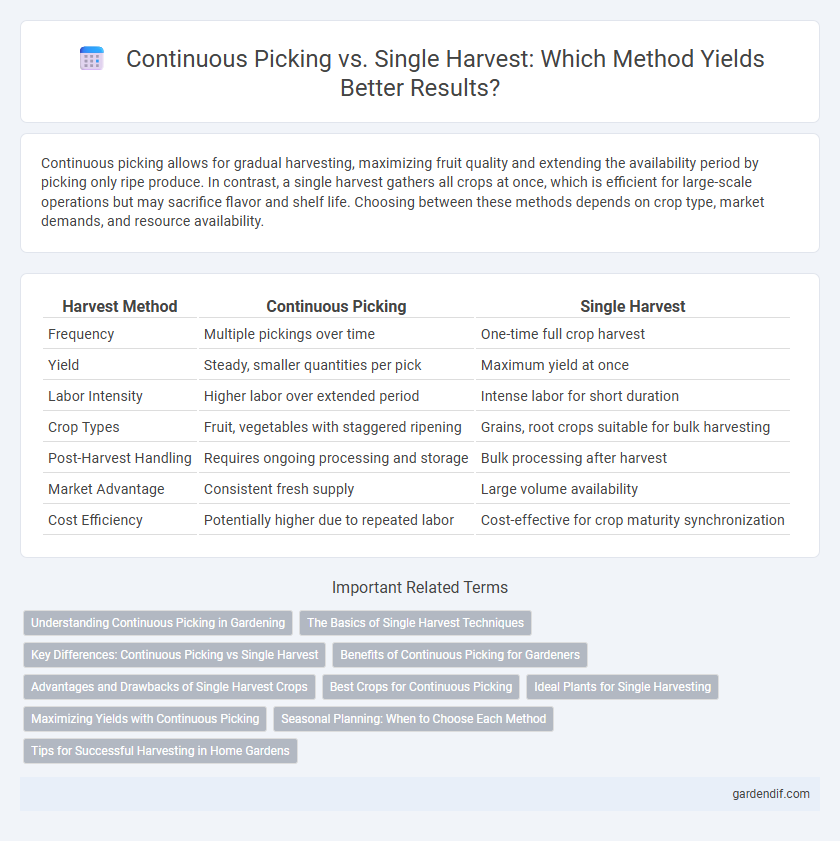
Continuous picking vs Single harvest Illustration
Continuous picking allows for gradual harvesting, maximizing fruit quality and extending the availability period by picking only ripe produce. In contrast, a single harvest gathers all crops at once, which is efficient for large-scale operations but may sacrifice flavor and shelf life. Choosing between these methods depends on crop type, market demands, and resource availability.
Table of Comparison
| Harvest Method | Continuous Picking | Single Harvest |
|---|---|---|
| Frequency | Multiple pickings over time | One-time full crop harvest |
| Yield | Steady, smaller quantities per pick | Maximum yield at once |
| Labor Intensity | Higher labor over extended period | Intense labor for short duration |
| Crop Types | Fruit, vegetables with staggered ripening | Grains, root crops suitable for bulk harvesting |
| Post-Harvest Handling | Requires ongoing processing and storage | Bulk processing after harvest |
| Market Advantage | Consistent fresh supply | Large volume availability |
| Cost Efficiency | Potentially higher due to repeated labor | Cost-effective for crop maturity synchronization |
Understanding Continuous Picking in Gardening
Continuous picking in gardening maximizes crop yield by harvesting ripe fruits and vegetables regularly throughout the growing season, unlike single harvest methods that collect all produce at once. This approach promotes plant health by reducing stress, encouraging further fruit production, and minimizing waste from overripe crops. Key benefits include extended freshness, improved flavor, and sustained garden productivity.
The Basics of Single Harvest Techniques
Single harvest techniques involve collecting an entire crop at once, maximizing uniformity and reducing labor time compared to continuous picking. This method is often preferred for crops like grains and root vegetables, where optimal ripeness occurs simultaneously. Proper timing and equipment calibration are essential to ensure quality and minimize post-harvest losses.
Key Differences: Continuous Picking vs Single Harvest
Continuous picking involves harvesting crops multiple times throughout the growing season, allowing for steady yields and reduced waste by picking ripe produce as it matures. Single harvest gathers the entire crop in one operation, maximizing efficiency in labor but increasing risk of losses from overripe or unripe produce. Key differences lie in timing, labor intensity, and crop quality management, with continuous picking favoring perishable fruits and vegetables, while single harvest suits grains and root crops.
Benefits of Continuous Picking for Gardeners
Continuous picking extends the harvest period by allowing gardeners to collect mature fruits and vegetables regularly, promoting consistent plant productivity. This method reduces waste by preventing overripe produce from spoiling and encourages healthier plants through continuous stimulation. Gardeners benefit from fresher crops, improved flavor, and the ability to spread labor over time rather than concentrating it into a single intensive harvest.
Advantages and Drawbacks of Single Harvest Crops
Single harvest crops allow for uniform crop maturity, facilitating efficient mechanized collection and reducing labor costs. However, this method can lead to a narrow harvesting window, increased risk of total crop loss from adverse weather, and often requires higher initial resource input for optimal yield. The lack of staggered production also limits market flexibility compared to continuous picking systems.
Best Crops for Continuous Picking
Continuous picking is ideal for crops such as tomatoes, strawberries, and beans, which produce fruit or pods periodically over an extended growing season, maximizing yield through regular harvesting. In contrast, single harvest crops like pumpkins and corn mature all at once, making them unsuitable for staggered picking. Choosing crops amenable to continuous picking enhances farm efficiency and market freshness by providing a steady supply of produce.
Ideal Plants for Single Harvesting
Certain crops such as wheat, rice, and corn are ideal for single harvest due to their synchronous ripening, which allows for efficient, large-scale collection. These plants typically have uniform maturation periods, minimizing the need for repeated labor and reducing harvest losses. Single harvest systems optimize yield quality and streamline post-harvest processing by gathering all produce at peak ripeness.
Maximizing Yields with Continuous Picking
Continuous picking enhances crop productivity by allowing multiple harvests throughout the growing season, leading to increased total yields compared to a single harvest. This method reduces crop stress and optimizes resource use by harvesting ripe produce incrementally, ensuring consistent market supply and higher profitability. Implementing continuous picking techniques can maximize crop value and improve farm efficiency by minimizing waste and extending harvest periods.
Seasonal Planning: When to Choose Each Method
Continuous picking suits perishable crops like strawberries or tomatoes, enabling daily harvesting to maximize freshness and reduce waste. Single harvest applies to grains or root vegetables, where mature crops are collected in bulk during optimal timing based on climatic conditions. Effective seasonal planning involves assessing crop type, market demand, and labor availability to determine whether continuous picking or single harvest maximizes yield and profitability.
Tips for Successful Harvesting in Home Gardens
Continuous picking promotes extended crop productivity by encouraging plants to produce more fruits and vegetables over time, ideal for home gardens with limited space. Single harvest is suitable for crops that mature simultaneously, allowing for a concentrated collection effort and minimizing waste. To optimize home garden yields, regularly monitor plant maturity, harvest early in the day for best flavor and freshness, and use clean, sharp tools to prevent damage and disease.
Continuous picking vs Single harvest Infographic

 gardendif.com
gardendif.com